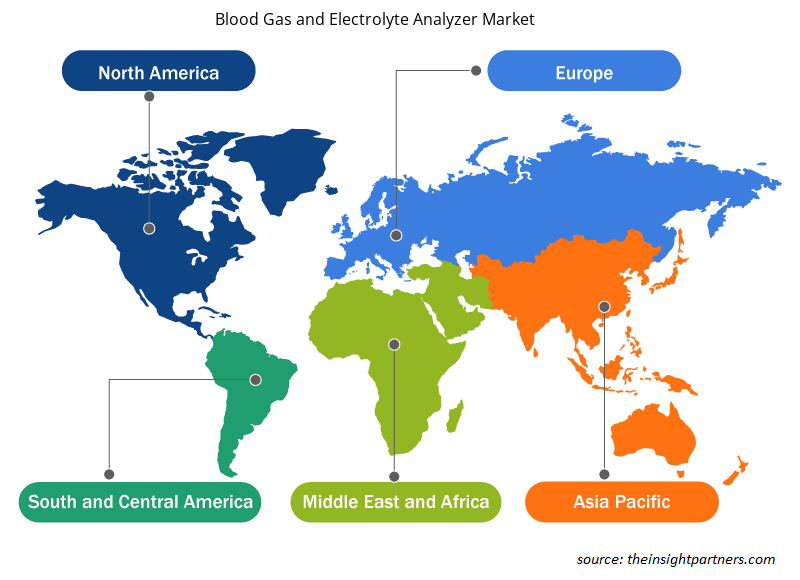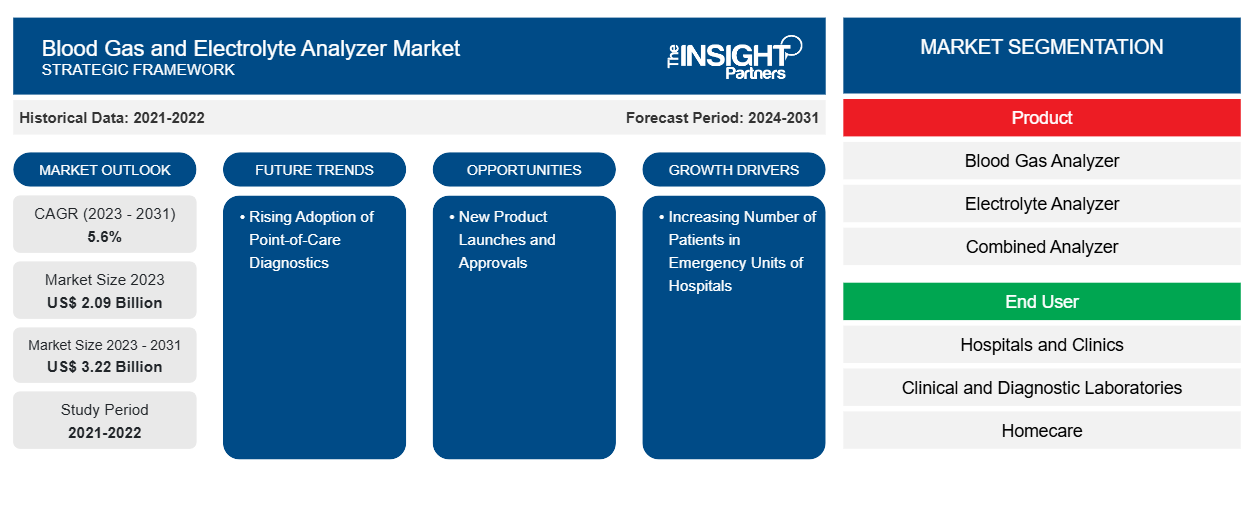血液ガスおよび電解質分析装置の市場規模は、2023年の20億9,000万米ドルから2031年には32億2,000万米ドルに達すると予測されています。市場は2023年から2031年の間に5.6%のCAGRを記録すると予想されています。血液ガスおよび電解質分析装置における自動化と人工知能は、今後も市場の主要なトレンドであり続けると思われます。
血液ガスおよび電解質分析装置市場分析
血液ガスおよび電解質分析装置市場の成長の重要な原動力の 1 つは、呼吸器疾患、腎臓疾患、糖尿病などの慢性疾患の罹患率の上昇です。これらの疾患では、適切な管理と治療を確実に行うために、電解質バランスと血液ガス レベルを頻繁に監視する必要があります。高齢者人口の増加により、これらの慢性疾患の罹患率が増加し、患者のケアをサポートし、臨床結果を改善するための血液ガスおよび電解質分析装置の需要が高まっています。さらに、結果の迅速化、電子医療記録との統合、精度の向上など、これらの分析装置の技術的進歩が、血液ガスおよび電解質分析装置市場の成長を牽引しています。
血液ガスおよび電解質分析装置市場の概要
血液ガスおよび電解質分析装置の自動化には、ロボット システム、サンプル処理メカニズム、および自動化されたワークフローの使用が伴い、検査プロセスの合理化、手動介入の削減、および結果のターンアラウンド タイムの短縮が図られます。自動化により、検査室の生産性が向上し、人的エラーのリスクが最小限に抑えられ、医療提供者にとって一貫性のある信頼性の高い診断結果が保証されます。自動化されたサンプル処理、インテリジェントな結果解釈、および予測分析により、医療提供者は患者の代謝状態、電解質バランス、および酸塩基平衡に関する包括的な洞察を得ることができ、情報に基づいた臨床判断と個別の治療戦略を促進できます。さらに、接続性とデジタル ヘルス ソリューションを統合することで、シームレスなデータ転送、リモート モニタリング、および医療チーム間のリアルタイムのコラボレーションが可能になり、効率的な患者ケアの提供と治療結果が最適化されます。
要件に合わせてレポートをカスタマイズする
このレポートの一部、国レベルの分析、Excelデータパックなど、あらゆるレポートを無料でカスタマイズできます。また、スタートアップや大学向けのお得なオファーや割引もご利用いただけます。
- このレポートの主要な市場動向を入手してください。この無料サンプルには、市場動向から見積もりや予測に至るまでのデータ分析が含まれます。
血液ガスおよび電解質分析装置の市場の推進要因と機会
病院の救急科の患者数増加が市場を有利に導く
救急病院の救急科で治療を求める患者数の増加は、血液ガスおよび電解質分析装置の需要にプラスの影響を与えています。世界保健機関(WHO)によると、世界中で毎年約1億5000万人の患者が病院の救急治療室を訪れています。2023年にCDCが発表したデータによると、米国では年間約1億3980万件の救急治療室への来院が記録されています。さらに、カリフォルニア州では2011年から2021年の間に救急治療室への来院が7.4%増加しました。救急科では重篤な患者を迅速かつ正確に評価するというプレッシャーが高まる中、血液ガス値、電解質レベル、酸塩基平衡に関するタイムリーな診断情報が最も重要になります。血液ガスおよび電解質分析装置は、呼吸困難、代謝異常、または重篤な状態に陥った患者の評価と管理のために、その場で診断データを提供します。患者の酸素化状態、酸塩基平衡、電解質レベルに関するリアルタイムの洞察を提供するこれらの分析装置の機能は、救急現場での蘇生措置を導き、臨床結果を最適化するために不可欠です。病院は増加する患者数のニーズを満たすために救急医療サービスの強化を優先しており、血液ガスおよび電解質分析装置市場では、緊急および重篤な医療現場に合わせた技術的に高度なソリューションの採用が増加しています。
新製品の発売と承認により市場機会が創出される
ヘルスケア業界の発展により、世界中のヘルスケア提供者の間で血液ガスおよび電解質分析装置の需要が高まっています。この需要の増加は、世界レベルでの新製品の開発、製品の発売、承認に貢献しています。さらに、主要な市場プレーヤーは、効率的な製品の革新と開発を確実にするために、研究開発活動に取り組んでいます。以下は、最近の製品の発売と開発の一部です。
- 2023 年 7 月、Siemens Healthineers は臨床化学および免疫測定検査用の新しい Atellica CI 分析装置を発売しました。米国食品医薬品局 (FDA) は、この分析装置を発売前に承認しました。現在、この装置はいくつかの国で利用可能です。
- 2022年7月、第74回米国臨床化学会年次学術会議および臨床検査博覧会(2022 AACC)において、EDAN Instruments, Inc.は、初のポイントオブケア(POC)蛍光ベースのCO-OX血液ガスおよび化学分析システムであるi20の発売を発表しました。このシステムには、血液ガスから電解質、COオキシメトリーまで、45を超えるパラメーターがあります。
したがって、市場プレーヤー間の製品開発、発売、戦略的コラボレーションの増加により、今後数年間で血液ガスおよび電解質分析装置市場に十分な機会が生まれる可能性があります。
血液ガスおよび電解質分析装置市場レポートのセグメンテーション分析
血液ガスおよび電解質分析装置の市場分析の導出に貢献した主要なセグメントは、製品とエンドユーザーです。
- 製品に基づいて、血液ガスおよび電解質分析装置市場は、血液ガス分析装置、電解質分析装置、複合分析装置、その他に分類されます。複合分析装置セグメントは、2023年に最大の市場シェアを占めました。
- エンドユーザー別に市場は以下のように分類されます。病院や診療所、臨床・診断研究所、在宅ケア環境など。臨床・診断研究所セグメントは、2023年に市場で最大のシェアを占めました。
血液ガスおよび電解質分析装置の地域別市場シェア分析
血液ガスおよび電解質分析装置市場レポートの地理的範囲は、主に北米、アジア太平洋、ヨーロッパ、中東およびアフリカ、南米および中米の 5 つの地域に分かれています。
2023年、血液ガスおよび電解質分析装置市場は北米が支配的でした。この地域の市場成長は、心血管疾患に関する一般の認識の高まりと、市場における革新的な治療用途を模索するための研究と協力の増加によって推進されています。北米の血液ガスおよび電解質分析装置市場は、市場にさまざまな主要プレーヤーが存在することで刺激されると予測されています。さらに、品質の向上とコストの削減のために医療業務に医療機器が導入されることで、この地域の市場成長が促進されます。アジア太平洋地域は、予測期間中に最高のCAGRを記録すると予想されています。
血液ガスおよび電解質分析装置市場の地域別分析
予測期間を通じて血液ガスおよび電解質分析装置市場に影響を与える地域的な傾向と要因は、Insight Partners のアナリストによって徹底的に説明されています。このセクションでは、北米、ヨーロッパ、アジア太平洋、中東およびアフリカ、南米および中米にわたる血液ガスおよび電解質分析装置市場のセグメントと地理についても説明します。

- 血液ガスおよび電解質分析装置市場の地域別データを入手
血液ガスおよび電解質分析装置市場レポートの範囲
| レポート属性 | 詳細 |
|---|---|
| 2023年の市場規模 | 20億9000万米ドル |
| 2031年までの市場規模 | 32億2千万米ドル |
| 世界のCAGR(2023年~2031年) | 5.6% |
| 履歴データ | 2021-2022 |
| 予測期間 | 2024-2031 |
| 対象セグメント | 製品別
|
| 対象地域と国 | 北米
|
| 市場リーダーと主要企業プロフィール |
|
血液ガスおよび電解質分析装置市場のプレーヤー密度:ビジネスダイナミクスへの影響を理解する
血液ガスおよび電解質分析装置市場は、消費者の嗜好の変化、技術の進歩、製品の利点に対する認識の高まりなどの要因により、エンドユーザーの需要が高まり、急速に成長しています。需要が高まるにつれて、企業は提供を拡大し、消費者のニーズを満たすために革新し、新たなトレンドを活用し、市場の成長をさらに促進しています。
市場プレーヤー密度とは、特定の市場または業界内で活動している企業または会社の分布を指します。これは、特定の市場スペースに、その市場規模または総市場価値に対してどれだけの競合相手 (市場プレーヤー) が存在するかを示します。
血液ガスおよび電解質分析装置市場で事業を展開している主要企業は次のとおりです。
- アボットラボラトリーズ
- ダルコ・ダイアグノスティクス株式会社
- エルバ・ダイアグノスティック・マンハイム GmbH
- F.ホフマン・ラ・ロシュ株式会社
- メディカ株式会社
- ノヴァ・バイオメディカル・コーポレーション
免責事項:上記の企業は、特定の順序でランク付けされていません。

- 血液ガスおよび電解質分析装置市場のトップキープレーヤーの概要を入手
血液ガスおよび電解質分析装置の市場ニュースと最近の動向
血液ガスおよび電解質分析装置市場は、主要な企業出版物、協会データ、データベースを含む一次および二次調査後の定性的および定量的データを収集することによって評価されます。市場におけるいくつかの動向を以下に示します。
- Sysmex America, Inc. は、XN-10 自動血液分析装置の血液銀行モードに残留白血球カウント機能を追加するための FDA 承認を取得しました。同社は、この新しい分析装置により、残留白血球数、赤血球 (RBC)、血小板 (PLT) 成分の検査を 1 回のサンプル吸引でサポートできるため、血液処理センターの効率、一貫性、精度が向上することを明らかにしました。(出典: Sysmex America、企業 Web サイト、2022 年 6 月)
- Sensa Core Medical Instrumentation は、診療所、病院、診断センターでの使用を目的とした ST-200 CC 血液ガス分析装置 – 超スマートを発売しました。同社の高度な血液ガスモデルは、ST-200 CC 超スマート ABGEM 血液ガス分析装置です。これは、イオン選択電極 (ISE)、インピーダンス (Hct)、およびアンペロメトリー (pO2) 技術による電流直接測定を使用して動脈血ガス分析と電解質測定を実行する、完全に自動化されたマイクロプロセッサ制御の電解質システムです。(出典: Sensa Core Medical Instrumentation、会社 Web サイト、2021 年 9 月)
血液ガスおよび電解質分析装置市場レポートの対象範囲と成果物
「血液ガスおよび電解質分析装置市場規模と予測(2021〜2031年)」レポートでは、以下の分野をカバーする市場の詳細な分析を提供しています。
- 血液ガスおよび電解質分析装置の市場規模と予測(対象範囲に含まれるすべての主要市場セグメントについて、世界、地域、国レベルで)
- 血液ガスおよび電解質分析装置の市場動向、ならびに推進要因、制約、主要な機会などの市場動向
- 詳細なPEST/ポーターの5つの力とSWOT分析
- 血液ガスおよび電解質分析装置の市場分析では、主要な市場動向、世界および地域の枠組み、主要プレーヤー、規制、最近の市場動向を取り上げています。
- 血液ガスおよび電解質分析装置市場の市場集中、ヒートマップ分析、主要プレーヤー、最近の動向を網羅した業界展望と競争分析
- 詳細な企業プロフィール
- 過去2年間の分析、基準年、CAGRによる予測(7年間)
- PEST分析とSWOT分析
- 市場規模価値/数量 - 世界、地域、国
- 業界と競争環境
- Excel データセット



Report Coverage
Revenue forecast, Company Analysis, Industry landscape, Growth factors, and Trends

Segment Covered
This text is related
to segments covered.

Regional Scope
North America, Europe, Asia Pacific, Middle East & Africa, South & Central America

Country Scope
This text is related
to country scope.
よくある質問
Answer: The increasing number of patients in emergency units of hospitals and the rising adoption of point-of-care diagnostics propel the blood gas and electrolyte analyzer market growth. However, the high costs of analyzers hamper the market growth. Automation and artificial intelligence in blood gas and electrolyte analyzers would bring new blood gas and electrolyte analyzer market trends in the coming years.
Answer: Blood gas analyzers are used to measure combinations of pH, blood gas (i.e. pCO2 and pO2), electrolytes, and metabolite parameters from whole blood samples. Blood conservation is an important initiative in every clinical diagnostic lab or critical care facility. Therefore, a highly accurate blood gas analyzer can streamline work processes and reduce errors with minimum maintenance. Most blood gas analyzers offer automatic sample mixing and easy sample aspiration with intuitive user interface built-in and automatic QC for accuracy and regulatory compliance.
Answer: - Based on product, the blood gas and electrolyte analyzer market is divided into blood gas analyzer, electrolyte analyzer, combined analyzer, and others. The combined analyzer segment held the largest market share in 2023.
By end user, the market is segmented into hospitals and clinics, clinical and diagnostics laboratories, homecare settings, and others. The clinical and diagnostic laboratories segment held the largest share of the market in 2023.
Answer: - The blood gas and electrolyte analyzers market majorly consists of the players such as Abbott Laboratories, Dalko Diagnostics Pvt Ltd, Erba Diagnostic Mannheim GmbH, F.Hoffmann-La Roche Ltd, Medica Corporation, Nova Biomedical Corporation, Siemens Healthineers AG, Werfen SA, Radiometer Medical ApS, and Sensa Core Medical Instrumentation Pvt Ltd.
Trends and growth analysis reports related to Life Sciences : READ MORE..
The List of Companies - Blood Gas and Electrolyte Analyzer Market
- Abbott Laboratories
- Dalko Diagnostics Pvt Ltd
- Erba Diagnostic Mannheim GmbH
- F.Hoffmann-La Roche Ltd
- Medica Corporation
- Nova Biomedical Corporation
- Siemens Healthineers AG
- Werfen SA
- Radiometer Medical ApS
- Sensa Core Medical Instrumentation Pvt Ltd
The Insight Partners performs research in 4 major stages: Data Collection & Secondary Research, Primary Research, Data Analysis and Data Triangulation & Final Review.
- Data Collection and Secondary Research:
As a market research and consulting firm operating from a decade, we have published and advised several client across the globe. First step for any study will start with an assessment of currently available data and insights from existing reports. Further, historical and current market information is collected from Investor Presentations, Annual Reports, SEC Filings, etc., and other information related to company’s performance and market positioning are gathered from Paid Databases (Factiva, Hoovers, and Reuters) and various other publications available in public domain.
Several associations trade associates, technical forums, institutes, societies and organization are accessed to gain technical as well as market related insights through their publications such as research papers, blogs and press releases related to the studies are referred to get cues about the market. Further, white papers, journals, magazines, and other news articles published in last 3 years are scrutinized and analyzed to understand the current market trends.
- Primary Research:
The primarily interview analysis comprise of data obtained from industry participants interview and answers to survey questions gathered by in-house primary team.
For primary research, interviews are conducted with industry experts/CEOs/Marketing Managers/VPs/Subject Matter Experts from both demand and supply side to get a 360-degree view of the market. The primary team conducts several interviews based on the complexity of the markets to understand the various market trends and dynamics which makes research more credible and precise.
A typical research interview fulfils the following functions:
- Provides first-hand information on the market size, market trends, growth trends, competitive landscape, and outlook
- Validates and strengthens in-house secondary research findings
- Develops the analysis team’s expertise and market understanding
Primary research involves email interactions and telephone interviews for each market, category, segment, and sub-segment across geographies. The participants who typically take part in such a process include, but are not limited to:
- Industry participants: VPs, business development managers, market intelligence managers and national sales managers
- Outside experts: Valuation experts, research analysts and key opinion leaders specializing in the electronics and semiconductor industry.
Below is the breakup of our primary respondents by company, designation, and region:

Once we receive the confirmation from primary research sources or primary respondents, we finalize the base year market estimation and forecast the data as per the macroeconomic and microeconomic factors assessed during data collection.
- Data Analysis:
Once data is validated through both secondary as well as primary respondents, we finalize the market estimations by hypothesis formulation and factor analysis at regional and country level.
- Macro-Economic Factor Analysis:
We analyse macroeconomic indicators such the gross domestic product (GDP), increase in the demand for goods and services across industries, technological advancement, regional economic growth, governmental policies, the influence of COVID-19, PEST analysis, and other aspects. This analysis aids in setting benchmarks for various nations/regions and approximating market splits. Additionally, the general trend of the aforementioned components aid in determining the market's development possibilities.
- Country Level Data:
Various factors that are especially aligned to the country are taken into account to determine the market size for a certain area and country, including the presence of vendors, such as headquarters and offices, the country's GDP, demand patterns, and industry growth. To comprehend the market dynamics for the nation, a number of growth variables, inhibitors, application areas, and current market trends are researched. The aforementioned elements aid in determining the country's overall market's growth potential.
- Company Profile:
The “Table of Contents” is formulated by listing and analyzing more than 25 - 30 companies operating in the market ecosystem across geographies. However, we profile only 10 companies as a standard practice in our syndicate reports. These 10 companies comprise leading, emerging, and regional players. Nonetheless, our analysis is not restricted to the 10 listed companies, we also analyze other companies present in the market to develop a holistic view and understand the prevailing trends. The “Company Profiles” section in the report covers key facts, business description, products & services, financial information, SWOT analysis, and key developments. The financial information presented is extracted from the annual reports and official documents of the publicly listed companies. Upon collecting the information for the sections of respective companies, we verify them via various primary sources and then compile the data in respective company profiles. The company level information helps us in deriving the base number as well as in forecasting the market size.
- Developing Base Number:
Aggregation of sales statistics (2020-2022) and macro-economic factor, and other secondary and primary research insights are utilized to arrive at base number and related market shares for 2022. The data gaps are identified in this step and relevant market data is analyzed, collected from paid primary interviews or databases. On finalizing the base year market size, forecasts are developed on the basis of macro-economic, industry and market growth factors and company level analysis.
- Data Triangulation and Final Review:
The market findings and base year market size calculations are validated from supply as well as demand side. Demand side validations are based on macro-economic factor analysis and benchmarks for respective regions and countries. In case of supply side validations, revenues of major companies are estimated (in case not available) based on industry benchmark, approximate number of employees, product portfolio, and primary interviews revenues are gathered. Further revenue from target product/service segment is assessed to avoid overshooting of market statistics. In case of heavy deviations between supply and demand side values, all thes steps are repeated to achieve synchronization.
We follow an iterative model, wherein we share our research findings with Subject Matter Experts (SME’s) and Key Opinion Leaders (KOLs) until consensus view of the market is not formulated – this model negates any drastic deviation in the opinions of experts. Only validated and universally acceptable research findings are quoted in our reports.
We have important check points that we use to validate our research findings – which we call – data triangulation, where we validate the information, we generate from secondary sources with primary interviews and then we re-validate with our internal data bases and Subject matter experts. This comprehensive model enables us to deliver high quality, reliable data in shortest possible time.


 このレポートの無料サンプルを入手する
このレポートの無料サンプルを入手する